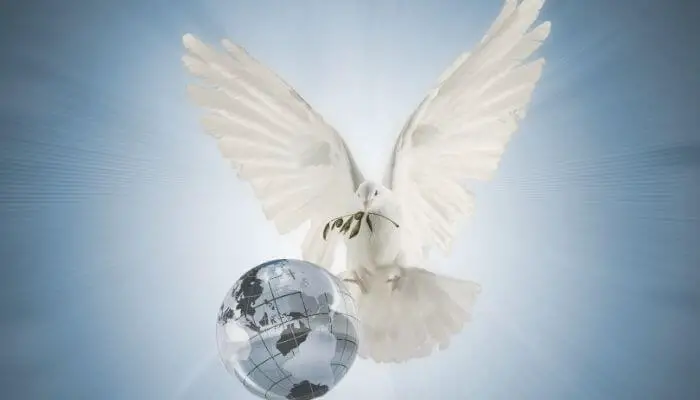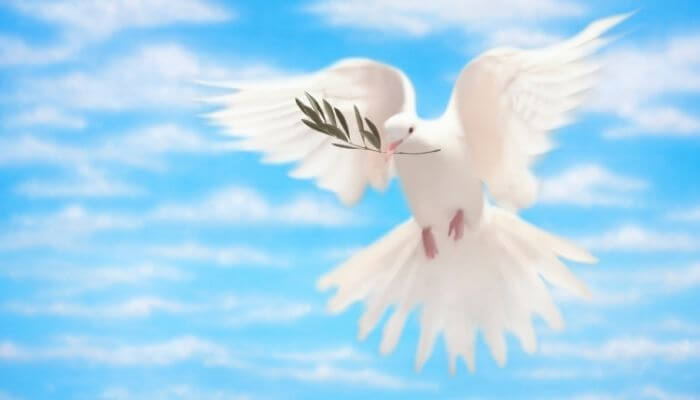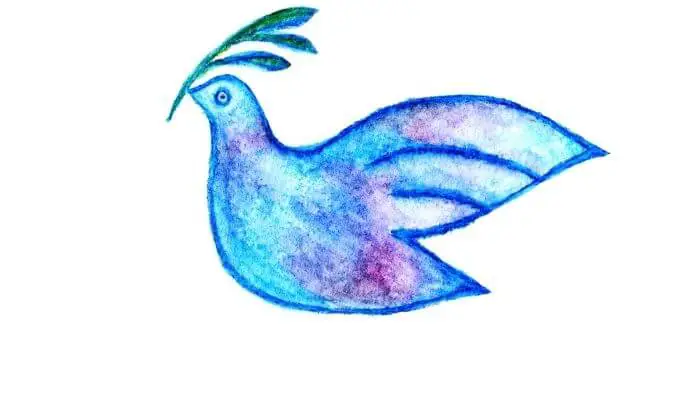A dove with an olive branch in its beak is a famous symbol.
It’s a depiction that has been used in many ways and has been around for centuries.
It appears in many religions as well as in paganism and some branches of the military.
Doves, Olive Branches & Judaism
The most well-known story associated with doves is that of Noah’s Ark, in which Noah released a dove after the flood had begun to recede.

The dove returned with an olive branch in its beak which was a signal that there was once again dry land.
Furthermore, the Talmud – the primary source of Judaism faith and law – likens the Spirit of God to a dove that cares for her babies.
Doves, Olive Branches & Christianity
The dove as a symbol can be found in the Bible in the book of Genesis which depicts the great flood and the story of Noah’s Ark.
In the New Testament of the Bible, the dove is associated with the baptism of Jesus.
In many branches of Christianity, the dove with an olive branch in its beak is seen as a symbol of peace and is associated with the baptism of its members.
It’s thought that the Holy Spirit appeared to Jesus in the form of a white dove, which is why the symbol has come to be associated with baptism.

In fact, the Holy Spirit is likened to a dove in many other instances throughout the Bible, primarily in the New Testament.
In some early Christian iconography, the dove also appears in funeral ceremonies.
It’s believed that it depicts the soul leaving the body and going to heaven.
It also appears as a symbol of peace in several Bible stories, including Daniel and the Lion’s Den and the Three Men in the Furnace.
The word dove appears in the bible more than a thousand times!
Oh, and the Archangel Gabriel is often depicted holding an olive branch.
Doves, Olive Branches & Paganism
In ancient Mesopotamia, the dove was a symbol of the goddess of love, war and sexuality.
It was believed that the goddess could take the form of the dove.
The Canaanite mother goddess and ancient Greek goddess Aphrodite were also associated with the white dove.
The dove was also a symbol of peace for the Ancient Romans.
There are records of generals offering an olive branch for peace after a battle and an olive branch is offered for peace by the main character in Aeneid by Virgil.
In many ancient temples and other structures, metal and marble doves have been found, indicating that the dove was seen as a symbol of many things dating back many centuries.
This explains the dove but what about the olive branch association?
The roots of those important ancient deities and figures associated with the dove are predominantly in Mediterranean countries.
After Athena gifted olive trees to the people of Athens, the tree became one of the most important crops, so the link was organic.
Winners in the ancient Olympic Games for example were crowned with a wreath made from olive leaves.
Out of interest, It isn’t just around the Mediterranean the symbol applies to.
In Hinduism, the dove is a sacred bird and killing one brings misfortune and the bird is a symbol of longevity in some Chinese traditions.
Doves, Olive Branches & Islam
Doves are looked upon favorably in Islam because it’s believed that they assisted Muhammed by distracting his enemies at the battle in the great Hijra.
The doves built a nest that tricked Muhammed’s enemies into thinking the cave was inhabited so that the other army looked elsewhere for him.
Doves, Olive Branches & The Royal Air Force
Because doves (and pigeons) were often used as messengers during the war, the Royal Air Force continues to use the dove in the crest for its Tactical Communications Wing.
Politics
Outside religion, the white dove also symbolizes peace and pacifism in politics.
They are often seen in political propaganda and as part of the signage for large world events, such as the Olympics. It’s also been used historically in peace marches and anti-war protests.
In some circles, pacifists are actually referred to as doves.

In some of these images the dove is seen holding the olive branch in its beak, while in others, it’s not.
In either case, the meaning is the same.
In 1949, one of Pablo Picasso’s doves was chosen as the emblem for the World Peace Conference.
It then became a symbol of the peace movement.
Pablo Picasso
The dove with olive branch appears in many works of art but no other artist is more associated with the bird than Picasso.
He created numerous images of doves – some with the olive branch others without.
His love of the glorious white bird is also shown in the name he gave his daughter – Paloma – the Spanish word for dove.
A dove holding an olive branch has a long and storied history as a symbol.
For most people, it’s associated with peace, though many religions continue to use the dove as part of their baptism ceremonies and to represent the Holy Spirit.
Look for it in churches, military buildings, government buildings and many other places.
